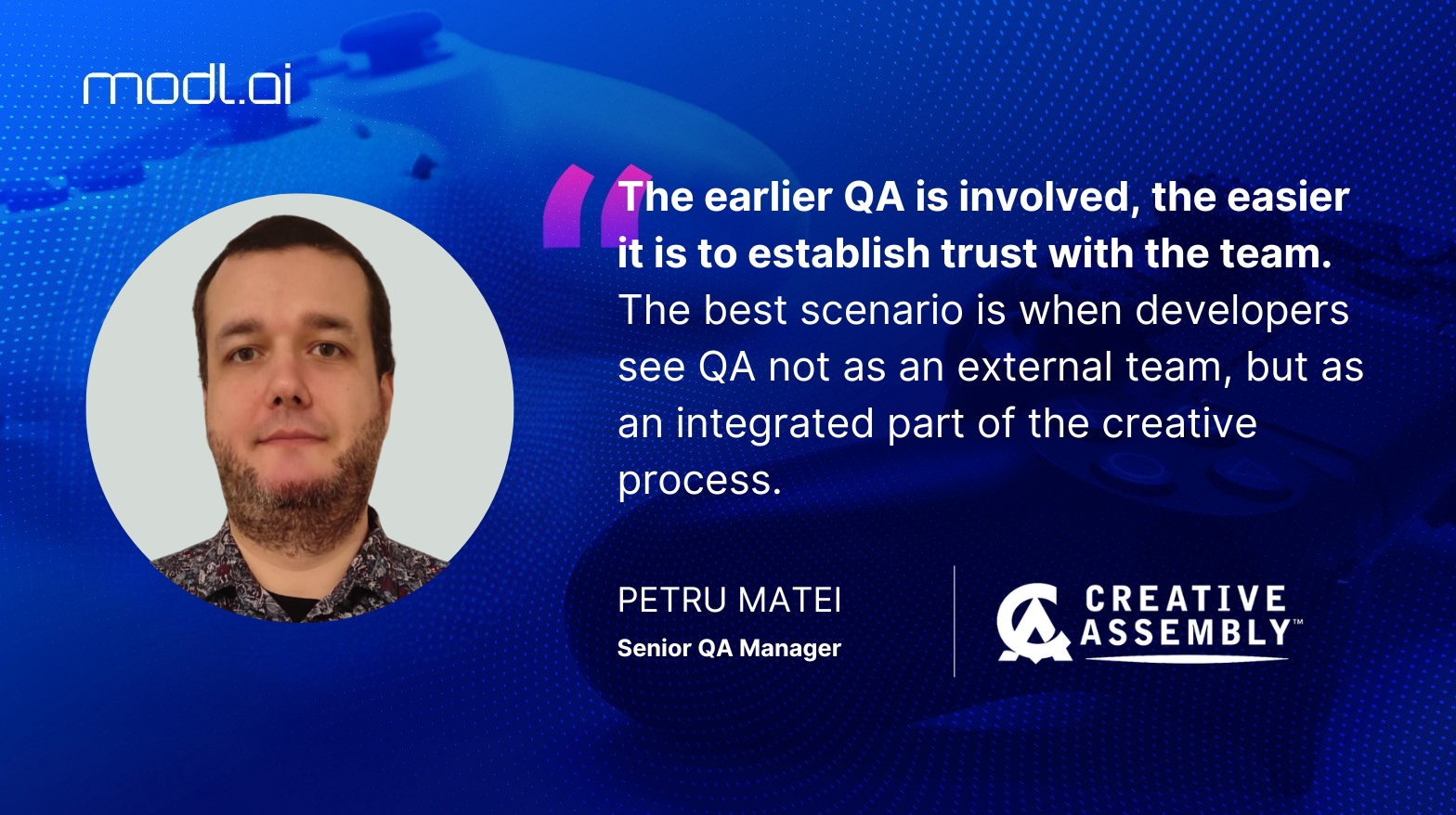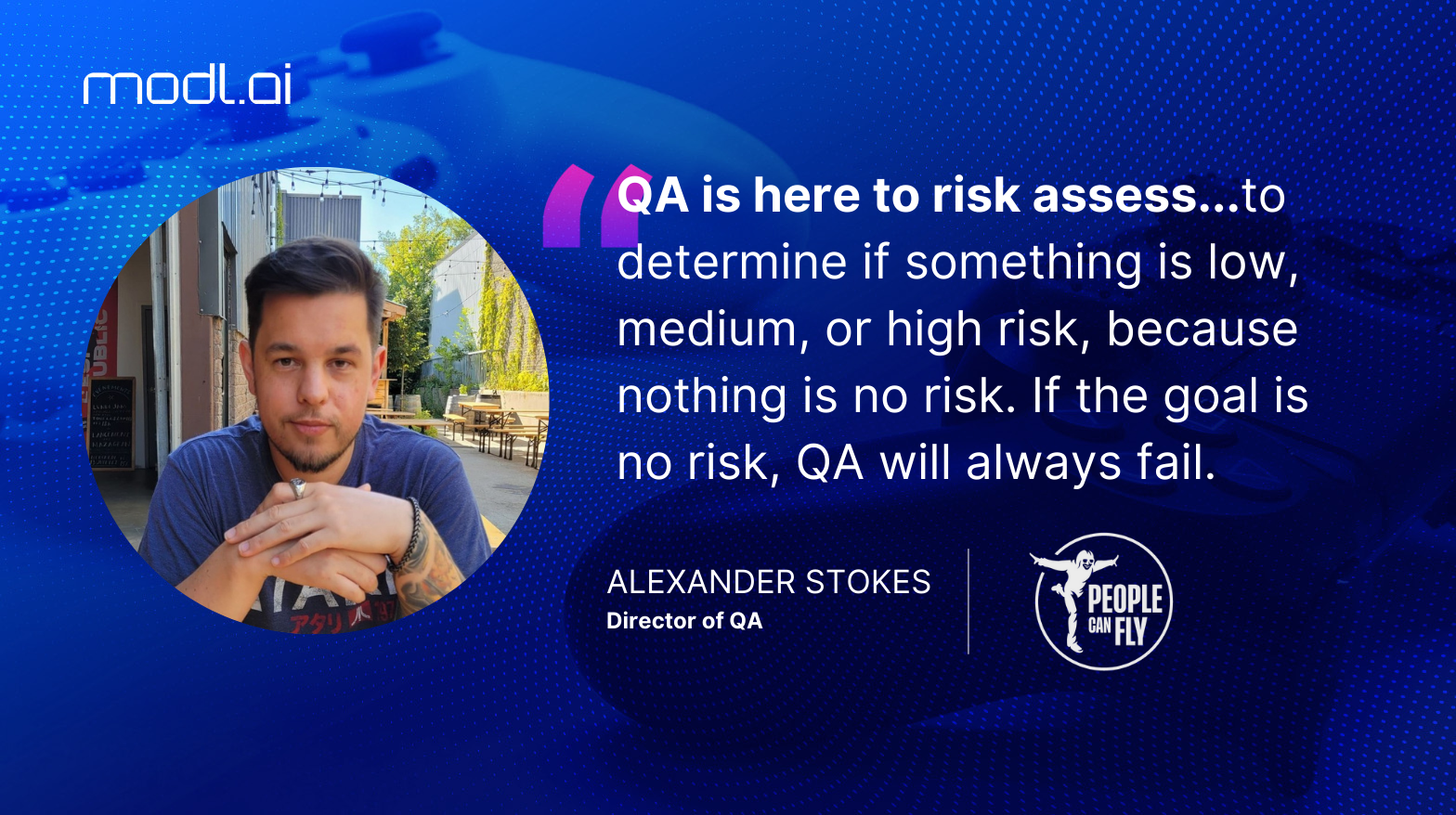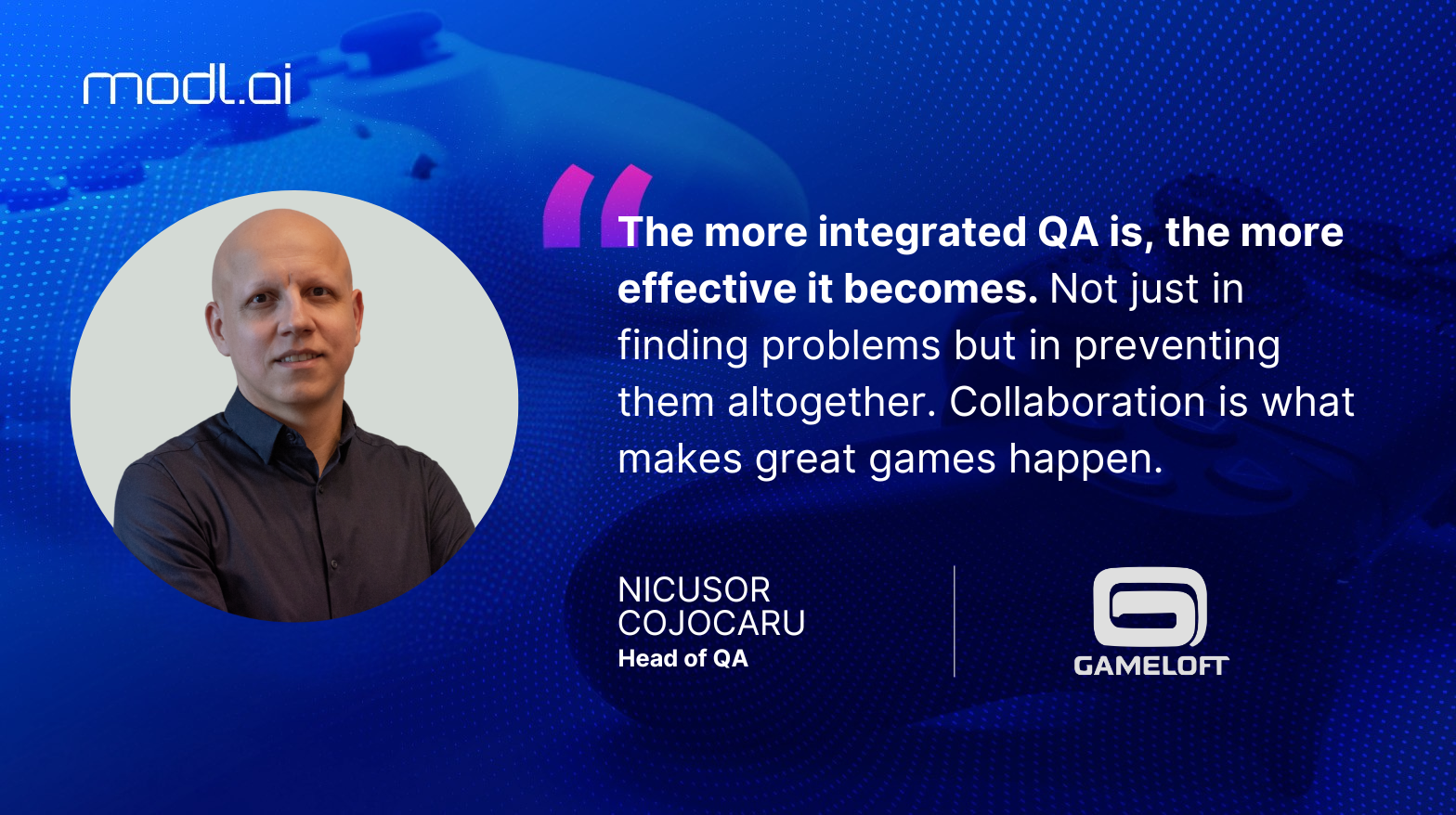Insight | Interview
Mastering QA at Scale: Insights From AAA Game Development Veteran, Petru Matei
How QA can be embedded in game development to drive quality, efficiency, and collaboration.
April 17, 2025

How QA can be embedded in game development to drive quality, efficiency, and collaboration.
Disclaimer: The opinions represented here are those of the individual and do not necessarily represent those of their employer.
Quality assurance (QA) in game development has long been perceived as a final check before release. However, industry leader Petru Matei, former Senior QA Manager at Creative Assembly, argues that QA should be embedded throughout the game development process to ensure higher-quality games with fewer last-minute crises. With nearly 20 years of experience spanning companies like Electronic Arts, Gameloft, and 505 Games, Matei has worked on some of the most complex AAA titles, tackling the challenges of scaling QA for massive projects. We talked with Petru to learn his insights on integrating QA effectively, leveraging automation, improving team collaboration, and navigating the ever-evolving landscape of game testing.
Key Takeaways
- Embed QA from the earliest stages of development to provide strategic insights and minimize risks later in the pipeline.
- Coordinate large-scale QA efforts strategically, using automation and targeted test coverage to maximize efficiency without excessive costs..
- Foster strong relationships between QA and other departments to shift the perception of QA from a gatekeeper to a valued partner.
- Balance proactive early-stage testing with reactive bug fixing to maintain stability throughout development.
- Leverage AI and automation to enhance QA, while relying on human expertise for creative problem-solving and complex test scenarios.
Embed QA from the earliest stages of development
A common misconception in game development is that QA’s primary role is to validate a finished product, but Matei argues that QA’s real value comes when it is embedded within the production process itself. He notes that in agile workflows, QA should be actively involved in daily stand-ups, retrospectives, and planning cycles, not just reacting to issues but helping shape the game alongside designers and engineers. Even in studios that still follow a waterfall structure, early QA integration can identify risks, streamline workflows, and provide crucial insights that improve game stability before production bottlenecks occur.
“If you join during the project, insist on being involved as early as possible. It’s significantly easier in agile development to have QA embedded in daily stand-ups, retrospectives, and planning cycles, but this should be the case in any development model. QA should be in backlog refinement meetings, engaging directly with production leads, designers, and engineers to discuss what’s coming next, where potential risks lie, and how testing can be structured efficiently.
The earlier QA is involved, the easier it is to establish trust with the team. And trust is everything. The best scenario is when developers see QA not as an external team that finds problems but as an integrated part of the creative process that helps avoid them in the first place. I’ve worked on projects where QA was engaged early, and the difference is night and day — it’s smoother, more efficient, and results in a more polished game.“
By integrating QA from the concept phase, teams can avoid costly late-stage issues and ensure that the game is built with quality in mind. Even with a small QA presence early on, developers gain valuable feedback on feasibility, player experience, and technical constraints — allowing them to refine ideas before they are set in stone. Matei emphasizes that early QA involvement leads to a shift in mindset: quality is no longer treated as a final check, but instead, becomes an inherent part of the game’s DNA. This reduces the number of costly late-stage bugs and fosters a culture of collaboration with all other developers and designers working together toward a common goal: delivering a seamless player experience.
Coordinate large-scale QA efforts strategically
AAA games require massive QA efforts, often involving hundreds of testers spread across multiple locations and time zones. Managing teams of this scale isn’t just about numbers — it’s about ensuring clear communication, structured workflows, and an efficient balance between human expertise and automation. Without proper coordination, large-scale QA can quickly become chaotic, leading to duplicated efforts, inefficient testing cycles, and critical issues slipping through the cracks.
Studios must establish strong leadership structures with clear communication chains between QA leads, development teams, and production managers. Additionally, geographic distribution presents challenges, especially when teams are working across different time zones. Ensuring seamless handoffs between regions is critical to maintaining efficiency and preventing bottlenecks in the testing pipeline.
“Coordinating between extremely large teams is the most complex issue. When I worked on Mass Effect: Andromeda, at one point, we had nearly 150 testers in Romania alone. If every team isn’t in sync, you waste countless hours testing the wrong things or missing critical coverage gaps. One key strategy is ensuring that QA leads from different locations are regularly in direct communication, not just with each other but with production and development. Without structure, you lose efficiency, and without efficiency, you waste both time and money.”
Automation is crucial in optimizing test coverage, handling regression testing, and running stress tests, especially at scale. By strategically deploying automation for repetitive tasks, such as verifying game stability across multiple hardware configurations, studios can free up human testers to focus on complex scenarios and player experience. However, Matei cautions against relying too heavily on automation without human oversight.
Automated tests are excellent for detecting crashes, performance drops, and other measurable issues, but they can’t fully replicate the nuanced decision-making of a human tester. The key to effective QA at scale is striking the right balance: Using automation to handle predictable, repeatable tests while ensuring that experienced QA professionals are focused on high-level gameplay issues, usability concerns, and nuanced player behaviors that benefit from human insight.
Foster strong relationships between QA and other departments
QA often encounters friction with the rest of the development, design, and production teams, sometimes being perceived as an external force that slows progress rather than a core contributor to game quality. This tension often arises from miscommunication, misaligned expectations, or a lack of understanding of QA’s role. However, Matei stresses that the key to breaking down these barriers is ensuring that QA is treated as an equal partner in the development process.
When QA is included in early discussions, actively contributes to planning, and has visibility into the evolving design and technical constraints, it strengthens collaboration across departments. Developers and designers begin to see QA not as a gatekeeper of issues but as an ally in refining the game, reducing last-minute fixes, and improving overall efficiency.
“Everyone needs to understand that we’re all pulling toward the same goal. QA, design, production, and development — at the end of the day, we all want to create the best possible game. The key is setting clear expectations and providing constructive feedback. If QA is involved from day one, we can flag potential risks early, provide insights that improve workflows, and help refine game mechanics before they become locked in. It’s also important that communication flows both ways. QA needs to be honest about challenges they face, but developers and designers also need to feel comfortable giving feedback on the testing process. When teams trust each other, QA isn’t seen as an obstacle but as a force multiplier that helps development move faster, not slower.”
Encouraging open communication, aligning on project goals, and involving QA in cross-departmental meetings help build trust and improve collaboration across the entire development team. Matei emphasizes that structured, regular interaction between QA leads and other department heads prevents misunderstandings and ensures that testing efforts align with production priorities. Whether it’s participating in sprint planning, attending feature reviews, or providing usability feedback, QA’s presence throughout the development lifecycle leads to a more refined product.
Balance proactive early-stage testing with reactive bug fixing
A common challenge in game development is finding the right balance between proactive testing, which ensures quality is built into the game from the start, and reactive bug fixing, which often intensifies as deadlines approach. Without a structured approach, teams can end up in a crunch cycle, where thousands of issues pile up just before release, overwhelming developers and testers alike.
Agile methodologies help mitigate this by integrating bug fixing into every development sprint, ensuring that defects are addressed incrementally rather than accumulating into a crisis. However, not all studios operate in an agile framework, and those still using waterfall methodologies must take a more strategic approach to avoid a last-minute avalanche of fixes. Matei highlights that regardless of the development model, studios that treat QA as an ongoing process rather than a final hurdle consistently ship higher-quality games with fewer delays.
“In agile, bug fixing should happen in every sprint. You find issues, you fix them, and you move on. If you’re waiting until the final months to fix everything, you’re already in trouble. It’s just not realistic to dump thousands of issues on development in the last few months and expect them to be resolved efficiently.
In waterfall, it’s a bit different because QA often ramps up later in production, but that doesn’t mean teams should ignore proactive testing. The key is prioritization — QA needs to focus on critical issues first and avoid wasting resources on low-impact bugs that won’t meaningfully affect the player experience.
And it’s not just about fixing bugs, it’s about catching potential design flaws early. If a mechanic doesn’t feel right, if an interaction is frustrating, those things need to be flagged long before the game is content-complete. The earlier QA gets involved, the fewer last-minute fires there will be.”
For studios still using waterfall methodologies, Matei advises prioritizing critical issues and focusing on predictable user paths to maximize impact with limited time. Not every bug is created equal, and during the final stretch of development, teams must be ruthless in deciding which issues truly need fixing before launch. He emphasizes that proactive testing isn’t just about reducing the number of bugs, it’s about ensuring that the most critical aspects of the game function as intended. Test coverage should be strategic, focusing on core gameplay loops, frequent player interactions, and areas of the game that could significantly impact the overall experience.
Leverage AI and automation to enhance QA
As AI and automation technologies evolve, their role in QA expands beyond simple regression testing and scripted workflows. AI-driven tools can now analyze vast datasets, simulate user behaviors, and identify patterns in ways that were previously impossible. Automation is already streamlining testing by executing repetitive tasks like performance benchmarking, stress testing, and compatibility checks across different hardware configurations.
However, while these advancements improve efficiency, Matei stresses that AI and automation solutions should not be viewed merely as replacements for human testers, but as force multipliers that reduce the need for large teams by offloading repetitive and time-consuming tasks. AI can process massive amounts of data and run thousands of test cases in a fraction of the time it would take a human team, but it lacks the adaptability, intuition, and critical thinking required to assess complex gameplay experiences.
“AI should help us be more creative in our work. It can generate test ideas, analyze competitor games, and automate repetitive tasks, but human intuition and problem-solving will always be essential. You can use AI to scan Steam reviews and identify common complaints about similar games, helping QA teams anticipate what players might find frustrating. You can also automate things like stress tests, keeping the game running for weeks to find memory leaks or performance degradation. But AI still can’t replace the judgment of an experienced tester who understands the nuances of player experience — things like whether a mechanic feels satisfying, whether a difficulty curve makes sense, or whether something just feels off. That’s where human testers will always be critical.”
AI-driven automation can significantly boost efficiency, but QA teams must strategically decide which tasks to automate while ensuring human testers focus on areas that require adaptability and deep analysis. Matei emphasizes that the best use of AI is to free up testers to do higher-value work. Instead of spending hours on manual regression testing, teams can use AI to handle those tasks while testers focus on subjective elements like game balance, narrative consistency, and user experience. As AI tools continue to improve, studios that adopt a hybrid approach — leveraging AI for efficiency while relying on human expertise for critical decision-making — will have the strongest QA processes.
Build better games with smarter QA
QA is evolving from a last-minute checkpoint to an integral part of game development. By embedding QA early, leveraging automation, fostering collaboration, and maintaining a strategic balance between proactive and reactive testing, studios can deliver higher-quality games with fewer late-stage surprises. As AI continues to evolve to encompass greater testing capabilities, the human element remains critical in shaping innovative and engaging player experiences.
For more insights, follow Petru Matei on LinkedIn and stay tuned for expert perspectives on game development and QA best practices.
Is your studio ready to implement these principles? Exploring AI-driven testing tools like modl.ai is a great place to start in building a more resilient, player-focused QA pipeline.


